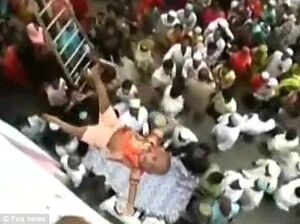Relevance Of Baby Tossing In Todays World

Baby Tossing is an Indian Ritual followed in certain parts of India where infants under the age of 2 years, are shaken by the priest and then dropped from a 30 to 50 feet shrine or mosque. While the origins of it is not known clearly,[1] this ritual is now celebrated in the first week of December.[2] It is practiced by Hindus and Muslims in rural regions of Maharashtra and Karnataka states in India. Example: Baba Umer Dargah and Digambareshwara Temple in Nagrala village. Every year two hundred families participate and over two hundred infants are tossed from a height.
History

The Baby Tossing ritual has been practiced for over seven hundred years. It began during the times when the infant mortality rate was high and there was a lack of medical advances. The ritual began as a resolution for the lack of understanding of the cures for ailing and dying children and people of the regions belief and faith in the Almighty and priest. The parents of the ailing and dying babies were advised by a priest to build a shrine and throw their ailing baby from the roof. If they truly believed and trusted in the almighty, a hammock-like sheet would appear in mid-air for their safety.[3] There are no reported mortality or injuries of children from this ritual.[4]
Recent Times
Over the last fifty plus years, Baby Tossing Ritual has evolved. It no longer is related to the dying or ailing children but rather is a celebration in certain parts of India and it is strongly believed to be a religious duty for the devotees.[5] In this ritual a priest shakes the baby a few times and then drops it down from a 30 to 50 feet shrine and a group of men are standing down holding a sheet for the safe landing of the baby.[6] If the baby lands safely, the crowd and relatives of the baby celebrate, sing and dance and pass each infant around before returning them to their mother.[7]

Reasons
- It is believed to be their religious duty.[8]
- The villagers believe that the ritual brings good luck and a long life for the child.[9]
- Couples participate in this ritual in the hope that they will be blessed with their own children.[10]
- People that participate in this ritual believe that it ensures good health and prosperity for them.[11]
Efforts Made to Ban the Ritual
In 2009, the National Commission for Protection of Child Rights made attempts to ban the ritual. The practice resumed again in 2011 at the Digambareshwara Temple.[12] An appeal for the government intervention by the National Commission for Protection of Child Rights would be done.[13]
Evolution of the ritual in the last 700 years
| 700 years | Now |
|---|---|
| Was practiced due to high child mortality rate and the parents belief in the almighty and priest. | Has become a celebration with a belief that the ritual will bring good luck and health to the child, family and people who participate in the celebration. |
| There wasn’t advanced medication for the dying infants. | Medicine has advanced and vaccinations have become compulsory after birth. |
| The babies were dropped down without any protection and it was believed that the almighty would miraculously make a hammock like sheet appear in mid-air. | There are men standing down holding a sheet for the baby to fall down safely. |

Relevance In Todays World
The advancing medical facilities in India significantly cuts down the infant mortality rate when compared to 700 years ago. To reduce the under-five mortality rates in India there have been considerable efforts made over the last three decades.[14] Mandatory vaccinations for chickenpox, influenza, tuberculosis, hepatitis, measles, mumps, rubella, polio, etc are available in the country and awareness campaigns for taking the vaccinations are done. Example: Pulse Polio
While we have evolved our medical and technology facilities and how our country has evolved in the last 700 years. The facilities provided now are received in no time because of the leading technology which helps us in various aspects including healthcare, but the practice still continues, albeit as a celebration.
References
- ↑ Nimmi. (n.d.). Significance of Baby Tossing. Retrieved from https://www.indianmirror.com/culture/indian-folklore/Baby-Tossing.html.
- ↑ Hyslop, L. (2009, December 11). Indian baby tossing ceremony may be banned. Retrieved from https://www.telegraph.co.uk/expat/expatnews/6771374/Indian-baby-tossing-ceremony-may-be-banned.html.
- ↑ Venkataraman, A. (2016, July 28). For Babies in India, a 30-Foot Plunge for Good Luck. Retrieved from https://www.nytimes.com/2016/07/29/world/what-in-the-world/for-babies-in-india-a-30-foot-plunge-for-good-luck.html.
- ↑ Nimmi. (n.d.). Significance of Baby Tossing. Retrieved from https://www.indianmirror.com/culture/indian-folklore/Baby-Tossing.html.
- ↑ Nimmi. (n.d.). Significance of Baby Tossing. Retrieved from https://www.indianmirror.com/culture/indian-folklore/Baby-Tossing.html.
- ↑ Garland, I. (2012, April 8). Baby tossing ritual in Karnataka, India: Priests hurl children from 30ft for 'good luck'. Retrieved from https://www.dailymail.co.uk/news/article-2126845/Baby-tossing-ritual-Karnataka-India-Priests-hurl-children-30ft-good-luck.html.
- ↑ Kallarackal, A. (2014, January 29). Bizarre 'Throwing Babies Down From Rooftop' ritual in India. Retrieved from https://www.apnaahangout.com/baby-tossing-ritual-india/.
- ↑ Nimmi. (n.d.). Significance of Baby Tossing. Retrieved from https://www.indianmirror.com/culture/indian-folklore/Baby-Tossing.html.
- ↑ Venkataraman, A. (2016, July 28). For Babies in India, a 30-Foot Plunge for Good Luck. Retrieved from https://www.nytimes.com/2016/07/29/world/what-in-the-world/for-babies-in-india-a-30-foot-plunge-for-good-luck.html.
- ↑ Hyslop, L. (2009, December 11). Indian baby tossing ceremony may be banned. Retrieved from https://www.telegraph.co.uk/expat/expatnews/6771374/Indian-baby-tossing-ceremony-may-be-banned.html.
- ↑ Distasio, S., Ripley, Kruse, C., Graziano, J., & Adrian. (2016, September 26). Unbelievable Baby-Dropping Ritual. Retrieved from https://www.ripleys.com/weird-news/baby-dropping-ritual/.
- ↑ Nair, S., NairAuthor, S., & Nair, S. (2018, April 2). Read About This Indian Custom Of Throwing Babies Off Buildings For Luck. Retrieved from https://www.edtimes.in/read-about-this-indian-custom-of-throwing-babies-off-buildings-for-luck/.
- ↑ https://www.theaustralian.com.au/news/world/baby-ritual-labelled-barbaric/news-story/d5a0ba6653d95015076982717e1d2a2e
- ↑ Sharma, S. (n.d.). Childhood Mortality and Health in India. Institute of Economic Growth. Retrieved from http://iegindia.org/upload/pdf/wp292.pdf